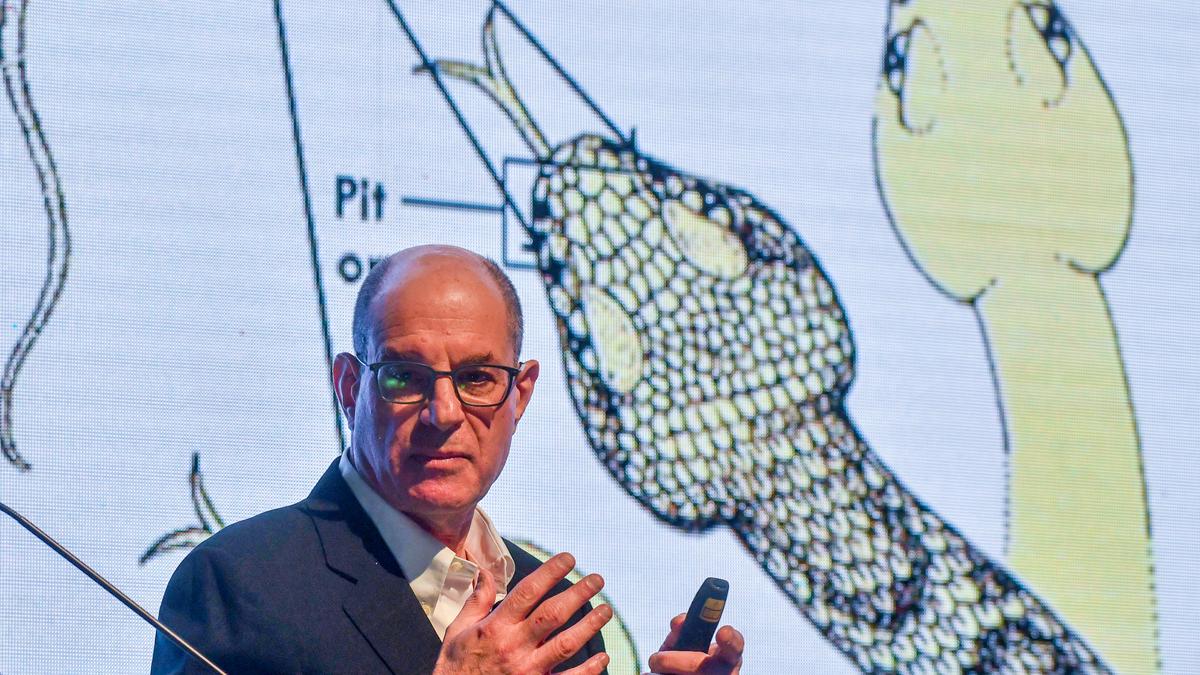
Understanding body’s perception of pain key to evolving new drugs: David Julius
The Hindu
TNQ lecture series: David Julius, biochemist, molecular physiologist and co-recipient of the 2021 Nobel Prize in Physiology, on how we sense pain
The sensation of pain while universal can also be influenced by culture. Though there is progress in understanding new pathways on how pain is processed at a bio-chemical level in the body, the current class of painkillers that consist of opioids and non-steroidal anti-inflammatory drugs (NSAID) will remain the mainstay of treatment for a long time, said David Julius, biochemist, molecular physiologist and co-recipient of the 2021 Nobel Prize in Physiology.
Dr. Julius addressed scientists and students at a talk, on Friday, as part of the annual TNQ Distinguished Lectures in the Life Sciences. In a nearly two-hour discourse, where he spoke on the topic, ‘How we sense pain’ and took a range of questions from the audience at the Jawaharlal Nehru Auditorium, All India Institute of Medical Sciences (AIIMS) in New Delhii, Dr. Julius described his scientific journey as a student and biologist and how he discovered a novel pathway and pain receptor – called TRPV1 – that responds to capscacin, the compound in chilli peppers that gives the sensation of heat. While capsaicin was already known to activate nerve cells causing pain sensations, how the chemical actually exerted this function was an unsolved riddle. Through his investigations, he discovered a heat-sensing receptor that is activated at temperatures perceived as “painful.”
Understanding how the body manages pain is an extremely important field of investigation because while the pain-pathway system protects the body by acting as a warning system against tissue damage from changes in the environment, such as burns or injuries, it “can also flip” and become hyper-sensitive causing chronic pain. “Lower back pain is a completely different experience from migraine pain and until we know what differentiates one from the other, it will be difficult to come up with new therapeutic options,” he added.
Chilli peppers and capsaicin, the degree to which are they are activated to induce sensations of burning, heat and discomfort play a key role in Dr. Julius’s investigation.
Responding to a question on what people in hot climates relishing a fiery chilly could have to do with how the body regulates temperature, Dr. Julius had this to say: on a hot day in a field, the core temperature in the body would rise. Biting into a chilli would trigger sensations of heat that would then signal to the body to activate responses to lower the ‘core temperature.’
“Mice that have been directly injected with capsaicin see their body temperatures rapidly falling. So this (eating spicy foods) is an efficient way to regulate body temperature. However behavioural adaptation is probably why different cultures have taken to it.” Birds and squirrels have a higher core temperature than humans and therefore have a higher tolerance to peppers and hot foods, he said in a response to a query on evolutionary adaptation to heat sensations.
Much of his research was possible due to grants that were generated from public funds. “The taxes that are paid should also be used to fund curiosity driven research – such as mine on peppers– and that’s the only way that we can move the science forward. Every country should have the equivalent of funding institutions such as the (US) National Institutes of Health,” said Dr Julius.

Podcasts have become our best friends, especially during the Covid-19 pandemic. Whether you are cooking, sketching or going on an evening walk, there is a show that matches your mood. From horror tales to informative conversations to just two friends talking about anything & everything relatable, podcasts have become a part of our lives unknowingly. Over the years, more voices have joined this audio landscape and filled it with stories that resonate with our lives. Podcasts serve as a reminder that everyone has a story worth telling and listening to!










